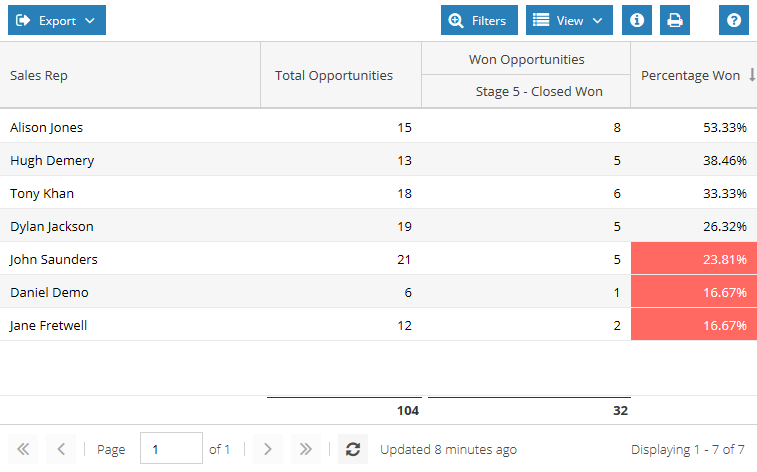Interested in learning more? Download our free whitepaper – Align Sales and Marketing for business success.
Close the loop between sales and marketing to increase lead conversion and grow revenue

Just like young siblings, sales and marketing can’t live with each other; but can’t live without each other either. Tension typically builds when the marketing team is left wondering why all the “brilliant” marketing leads that they are passing over have not been closed by sales, but, conversely, the sales team is continually disappointed with the quality of leads that they are receiving from the marketing team.
As is the case with most family squabbles, better communication and a more open dialogue between the two departments can turn this tension on its head and into something far healthier and productive. Key to this harmonious culture is a CRM system that is capable of meeting the needs of a busy marketing department together with the requests of an ever-demanding and pressured sales function.
We have outlined below seven key tips businesses should consider in order to create a more open communication channel and close the loop between sales and marketing once and for all:
1. Put in place a reliable process for tracking where leads have come from
 This involves recording the specific marketing activity that generated the lead (e.g. email marketing, advertising, social media, PR, event etc.) as well as the marketing investment that was made to acquire the lead. All of this information and data should be visible to both sales and marketing within your CRM.
This involves recording the specific marketing activity that generated the lead (e.g. email marketing, advertising, social media, PR, event etc.) as well as the marketing investment that was made to acquire the lead. All of this information and data should be visible to both sales and marketing within your CRM.
This information should push through to opportunity and even order records, allowing sales and marketing teams to measure and benchmark campaigns effectiveness (conversion rates, pipeline, ROI), and help with decision making relating to future marketing investment.
2. Put in place a strong lead scoring and lead nurturing process
 Don’t treat all sales leads as equal!
Don’t treat all sales leads as equal!
As well as being able to send carefully tailored content to nurture leads, marketing also needs to be able to recognise when a lead is not of a good enough quality, or not far enough down the buying process, to be passed over to sales. Only hand over marketing leads when they are ready!
Lead scoring and nurturing can easily be automated to gain greater efficiency.
3. Clear processes and guidelines on how to define leads is crucial
 Clear SLAs (Service Level Agreement) need to be in place between sales and marketing. Within what timeframe should sales follow-up on a lead that has been passed? What information should be included? The handover process should be discussed between the two teams and agreement reached.
Clear SLAs (Service Level Agreement) need to be in place between sales and marketing. Within what timeframe should sales follow-up on a lead that has been passed? What information should be included? The handover process should be discussed between the two teams and agreement reached.
It is particularly important to ensure that each department is committed and understands:
- What defines a lead that should be nurtured by marketing.
- What defines a lead that is ready to be passed over to sales.
- What defines a lead that should be passed back to marketing.
4. Record why a marketing lead was successfully converted
 What was it that pushed that lead over the line? This is important learning that can then be replicated again when dealing with similar prospects and leads. Better understanding will drive best practices and ensure ongoing success.
What was it that pushed that lead over the line? This is important learning that can then be replicated again when dealing with similar prospects and leads. Better understanding will drive best practices and ensure ongoing success.
5. But – perhaps more importantly – have a clear process for recording why you lost a deal or why sales qualified it out
 Understanding why sales have qualified out a deal is perhaps even more important than knowing why a deal was won. For marketing to ensure that only the best quality leads are passed across to sales, the team needs to understand what qualifies them out from a sales perspective.
Understanding why sales have qualified out a deal is perhaps even more important than knowing why a deal was won. For marketing to ensure that only the best quality leads are passed across to sales, the team needs to understand what qualifies them out from a sales perspective.
Perhaps the company profile is wrong (size, industry), perhaps they are not looking to change but instead make better use of what they have…? Whatever the reason, marketing can only target its activities correctly when it knows what ‘wrong’ looks like.
Including a specific area in the sales lead record and sales opportunity record in your CRM system that captures the “Status” of a lead (e.g. ‘Qualified Out – Not a real lead’ or ‘Qualified Out – too small’ or ‘Lost to Competitor’ or ‘Won’) and a more detailed “Qualified Out Reason” where the sales rep can enter why the lead was lost or won can easily solve this. But remember – your sales team must see the value in adding this information and your marketing team must track this information and listen to it!
Example summary report:
|
Lost or Qualified Out Category |
Total Leads or Opps |
Total Amount / Value |
|
1 Lost – Price |
7 |
£20,000 |
|
1 Lost – Bought Competitor |
5 |
£15,000 |
|
1 Lost – Product issue |
6 |
£13,000 |
|
1 Lost – Didn’t make short list |
2 |
£5,000 |
|
1 Lost – Didn’t like brand |
5 |
£16,000 |
|
1 Lost – Outsold |
5 |
£17,500 |
|
1 Lost – Other reason |
2 |
£1,450 |
|
2 Stayed with existing product |
1 |
£5,000 |
|
3 Qualified Out – Not a real lead |
8 |
£13,000 |
|
3 Qualified Out – Could not contact |
10 |
£5,000 |
|
3 Qualified Out – Too small |
5 |
£12,000 |
|
3 Qualified Out – Other reason |
2 |
£3,000 |
|
4 Won |
50 |
£60,000 |
Detailed report:
|
Lead or Opp Name |
Lost or Qualified Out Category |
Amount / Value of Lead or Opp |
Marketing Campaign |
Won, Lost or Qualified Out comment |
|
Motor Car Insurance Plc |
1 Lost – Price |
£1,325 |
Social Media |
Product too expensive. Went for cheaper alternative |
|
The Transport Company |
3 Qualified Out – Not a real lead |
£0 |
Email Marketing |
Doing research, not looking to buy. |
|
Train Lines Inc |
4 Won |
£10,000 |
Linkedin Sponsored Update |
Preferred the on-going vendor support that we offer and felt the price was very reasonable. |
6. Share dashboards and reports between sales and marketing teams
 Provide your teams with visibility of what marketing activities are resulting in won deals along with where you are losing leads and why. This will make both teams accountable: marketing for quality and sales for what is happening to leads after handover; and it also provides sales with a lead feedback channel that is shared across both departments.
Provide your teams with visibility of what marketing activities are resulting in won deals along with where you are losing leads and why. This will make both teams accountable: marketing for quality and sales for what is happening to leads after handover; and it also provides sales with a lead feedback channel that is shared across both departments.
7. Build a Sales process

A sales framework provides a common language – allowing team members to understand where they are in the sales cycle, enable the business to measure success at each stage & identify where to drive improvements. We recommend you start with:
Reviewing Pipeline Metrics
- Conversion rate by rep/stage
- Lead quantity
- Age of Pipe
- Win/loss analysis
Reviewing Sales Reps
- Performance levels
- Activity levels
- Deal planning
- Pipeline movements
Once you’ve got your data into your CRM and assign it within a well thought-out sales process, you can pull some actionable insight. For example once you know your close rate, average deal value and average sale cycle time, you can easily calculate how many new leads your Sales and Marketing team will need to generate in order for your business to fill your sales pipeline with enough opportunities to reach your sales targets.
For more information on building a Sales process see our recent blog post.
Even if you only try a few of the recommendations above, we can guarantee you that you’ll see a substantial difference. You’ll build great efficiency throughout your sales funnel, increase conversion and ultimately generate more revenue.